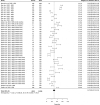Prevalence of multidrug-, extensive drug-, and pandrug-resistant commensal Escherichia coli isolated from healthy humans in community settings in low- and middle-income countries: a systematic review and meta-analysis
- PMID: 32909519
- PMCID: PMC7782630
- DOI: 10.1080/16549716.2020.1815272
Prevalence of multidrug-, extensive drug-, and pandrug-resistant commensal Escherichia coli isolated from healthy humans in community settings in low- and middle-income countries: a systematic review and meta-analysis
Abstract
Background: The majority of existing studies aimed at investigating the incidence and prevalence of multidrug-resistance by bacteria have been performed in healthcare settings. Relatively few studies have been conducted in community settings, but these have consistently shown a high prevalence of multidrug-resistant bacteria in low- and middle-income countries (LMICs).
Objectives: To provide an appraisal of the evidence on the high prevalence of multidrug-, extensive drug-, and pandrug-resistance in commensal Escherichia coli isolates from human sources in community settings in LMICs.
Methods: Using the preferred reporting items for systematic reviews and meta-analyses (PRISMA) guidelines, PubMed, EMBASE, MEDLINE, Web of Science, CINAHL, and Cochrane Library databases were systematically searched with the search string: 'Enterobacteriaceae', OR 'E. coli', OR 'Escherichia coli', AND 'antibiotic resistance', OR 'antimicrobial resistance', OR 'drug-resistance', AND 'prevalence', OR 'incidence', OR 'morbidity', OR 'odds ratio', OR 'risk ratio', OR 'confidence interval', OR 'p-value', OR 'rate'. Data were extracted and proportional meta-analysis was performed using the Freeman-Tukey transformation random effect model.
Results: The prevalence of multidrug-, extensive drug- and pandrug-resistance were extracted from articles that met our inclusion criteria and pooled together after a systematic screening of 9,369 items. The prevalence of multidrug-resistance was 28% of 14,336 total cases of isolates tested, 95% CI: 23-32. Extensive drug-resistance was 24% of 8,686 total cases of isolates tested, 95% CI: 14-36. Lastly, pandrug-resistance was 5% of 5,670 total cases of isolates tested, 95% CI: 3-8.
Conclusion: This paper provides an appraisal of the evidence on the high prevalence of multidrug-, extensive drug- and pandrug-resistance by commensal E. coli in community settings in LMICs. Our results call for greater effort to be placed at the community level in the design of new and improved public health policies to counter the global threat of antibiotic-resistant infections and bacteria.
Keywords: Antibiotic resistance; Antimicrobial Resistance; commensal Escherichia coli; community settings; health policy; multidrug resistance.
Conflict of interest statement
No potential conflict of interest was reported by the authors.
Figures




References
-
- Centers for Disease Control and Prevention (U.S.) Antibiotic resistance threats in the USA, 2019 [Internet]. Centers for disease control and prevention (U.S.); 2019. [cited 2020 July11]. Available from: https://stacks.cdc.gov/view/cdc/82532
-
- Rogers BA, Sidjabat HE, Paterson DL. Escherichia coli O25b-ST131: a pandemic, multiresistant, community-associated strain. J Antimicrob Chemother. 2011;66:1–10. - PubMed
-
- Pitout JD, Laupland KB. Extended-spectrum β-lactamase-producing Enterobacteriaceae: an emerging public-health concern. Lancet Infect Dis. 2008;8:159–166. - PubMed
-
- World Health Organization Antibiotic resistance [Internet]. World Health Organization; 2020. [cited 2020 August17]. Available from: https://www.who.int/news-room/fact-sheets/detail/antibiotic-resistance
Publication types
MeSH terms
LinkOut - more resources
Full Text Sources
Miscellaneous
